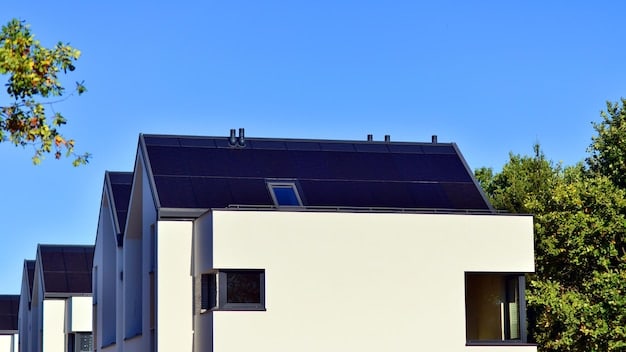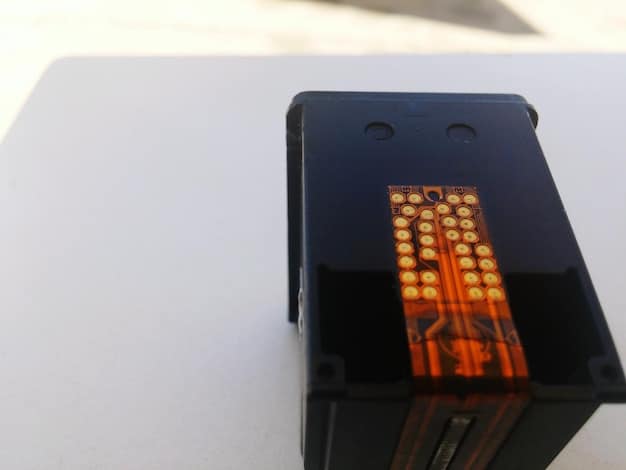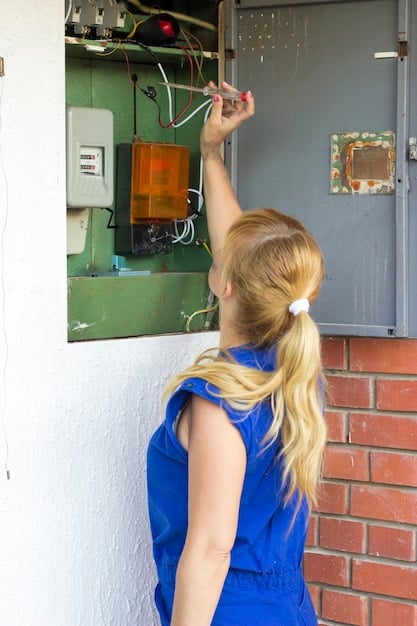Maximize Solar Power: Home Energy Storage Battery Systems Explained

Home energy storage solutions, particularly battery systems, are vital for maximizing the use of solar power by storing excess energy for later use, reducing reliance on the grid, and increasing energy independence.
Interested in harnessing the full potential of your solar panels? Home energy storage: battery systems to maximize solar power usage is the key. By storing excess solar energy, you can power your home even when the sun isn’t shining, reducing your reliance on the grid and saving money.
Understanding Home Energy Storage and Solar Power
Home energy storage systems are becoming increasingly popular as homeowners seek ways to maximize the benefits of solar power. These systems, primarily using batteries, store excess solar energy generated during the day, enabling its use during evenings, nights, or cloudy days.
The combination of solar panels and energy storage offers greater energy independence, reduces reliance on the utility grid, and can lead to significant cost savings over time. Let’s dive into how these systems work and why they’re so important.
How Home Energy Storage Works
Home energy storage systems work by capturing electricity generated by solar panels and storing it in rechargeable batteries. This stored energy can then be used to power your home when solar panels are not producing enough electricity, such as at night or during power outages.
The system typically includes a battery, an inverter, and a charge controller. The charge controller regulates the flow of electricity between the solar panels, battery, and home. The inverter converts the direct current (DC) electricity from the battery into alternating current (AC) electricity, which is used to power most household appliances.
Benefits of Combining Solar Power and Energy Storage
Combining solar power with energy storage provides numerous benefits. It increases energy independence by allowing you to use your own solar energy even when the sun isn’t shining. It also enhances grid resilience, providing backup power during outages and reducing strain on the grid during peak demand.
- Increased energy independence
- Reduced reliance on the grid
- Backup power during outages
- Cost savings through reduced electricity bills

In conclusion, home energy storage systems are a valuable addition to solar panel installations, offering increased energy independence and resilience. By understanding how these systems work and the benefits they provide, homeowners can make informed decisions about investing in this technology.
Types of Battery Systems for Home Energy Storage
When considering home energy storage, it’s essential to understand the different types of battery systems available. Each type has its own advantages and disadvantages, making it important to choose the one that best fits your energy needs, budget, and space constraints.
The most common types of battery systems include lithium-ion, lead-acid, and flow batteries. Let’s explore each of these in more detail.
Lithium-Ion Batteries
Lithium-ion batteries are the most popular choice for home energy storage due to their high energy density, long lifespan, and relatively low maintenance requirements. They are compact, efficient, and can be charged and discharged repeatedly without significant degradation.
However, lithium-ion batteries can be more expensive than other types and may require a sophisticated battery management system to ensure safe operation. They are also sensitive to extreme temperatures, which can affect their performance and lifespan.
Lead-Acid Batteries
Lead-acid batteries are a more traditional and cost-effective option for home energy storage. They are readily available and have a proven track record in various applications. However, they have a lower energy density and shorter lifespan compared to lithium-ion batteries.
Lead-acid batteries also require regular maintenance, such as checking and refilling electrolyte levels. They are heavier and bulkier than lithium-ion batteries, making them less suitable for space-constrained installations.
Flow Batteries
Flow batteries are an emerging technology for home energy storage, offering high energy capacity and long lifespan. They store energy in liquid electrolytes, which are pumped through a stack of electrochemical cells to charge and discharge the battery.
Flow batteries are scalable and can be designed for long-duration storage, making them suitable for applications where backup power is needed for extended periods. However, they are currently more expensive than lithium-ion and lead-acid batteries and may require a larger installation footprint.
In summary, the choice of battery system depends on your specific needs and priorities. Lithium-ion batteries offer high performance and convenience but come at a higher cost. Lead-acid batteries are a more affordable option but require more maintenance and have a shorter lifespan. Flow batteries offer long-duration storage but are still relatively expensive and require a larger footprint. Carefully consider these factors to choose the best battery system for your home energy storage needs.
Sizing Your Battery System to Match Solar Power Production
Properly sizing your battery system is crucial to maximizing the benefits of solar power. An undersized battery may not be able to store all the excess energy generated by your solar panels, while an oversized battery may be more expensive than necessary. The goal is to match the battery capacity to your energy consumption patterns and solar power production.
Several factors influence the optimal size of your battery system, including your energy usage, solar panel size, and backup power requirements. Let’s explore these factors in more detail.
Assess Your Energy Consumption
The first step in sizing your battery system is to assess your energy consumption. Review your electricity bills to understand how much energy you use on a daily and monthly basis. Identify peak usage periods and determine which appliances and devices consume the most energy.
This information will help you estimate the amount of energy you need to store in your battery to meet your needs during evenings, nights, or power outages. Consider seasonal variations in energy consumption, as you may use more energy during summer for air conditioning or winter for heating.
Consider Your Solar Panel Size
The size of your solar panel system also affects the optimal size of your battery system. A larger solar panel system will generate more energy, requiring a larger battery to store the excess. Conversely, a smaller solar panel system may not generate enough energy to fully charge a large battery.
Ideally, your battery system should be sized to store the excess energy generated by your solar panels during peak production hours. This will ensure that you can maximize self-consumption and reduce reliance on the grid.
Evaluate Backup Power Needs
If you plan to use your battery system for backup power during outages, you’ll need to consider the essential appliances and devices you want to keep running. Calculate the energy consumption of these devices and estimate how long you need to power them during an outage.
- Determine essential appliances to power during outages
- Calculate energy consumption of these appliances
- Estimate the duration of backup power needed
This will help you determine the minimum battery capacity required for backup power. Keep in mind that larger battery systems can provide longer backup power duration and support more appliances.
In conclusion, sizing your battery system is a critical step in maximizing the benefits of solar power. By assessing your energy consumption, considering your solar panel size, and evaluating your backup power needs, you can choose a battery system that meets your specific requirements and optimizes your energy savings.
Installation and Maintenance of Home Energy Storage Systems
Proper installation and maintenance are essential to ensure the safety, performance, and longevity of your home energy storage system. Installation should be performed by qualified professionals who are experienced in working with solar panels, batteries, and electrical systems.
Regular maintenance is also necessary to keep your battery system operating at peak efficiency and to identify any potential issues before they become major problems. Let’s explore the key aspects of installation and maintenance in more detail.

Professional Installation
Installing a home energy storage system involves connecting it to your solar panels, electrical panel, and home appliances. This requires expertise in electrical wiring, solar panel integration, and battery management systems. Improper installation can lead to safety hazards, such as electrical shocks, fires, or battery failures.
It’s crucial to hire licensed and certified installers who are familiar with local building codes and regulations. They should also provide a warranty for their work and offer ongoing support and maintenance services.
Regular Maintenance
Home energy storage systems require regular maintenance to ensure optimal performance and longevity. Maintenance tasks may include:
- Inspecting battery terminals for corrosion
- Checking electrolyte levels (for lead-acid batteries)
- Monitoring battery voltage and temperature
- Cleaning battery enclosures
Refer to the manufacturer’s recommendations for specific maintenance requirements. Some battery systems may require professional maintenance services, while others can be maintained by homeowners with basic electrical knowledge.
Safety Precautions
Working with electricity and batteries can be dangerous. It’s essential to follow safety precautions to avoid electrical shocks, burns, or other injuries. Always turn off the power before working on any electrical components.
Wear appropriate personal protective equipment, such as gloves and eye protection. Never attempt to repair or modify battery systems unless you are qualified to do so. If you suspect a problem with your battery system, contact a qualified technician for assistance.
In summary, proper installation and maintenance are critical for the safe and efficient operation of your home energy storage system. Hire qualified professionals for installation and follow the manufacturer’s recommendations for regular maintenance. Always follow safety precautions when working with electricity and batteries to avoid potential hazards.
Cost and Incentives for Home Energy Storage
Investing in home energy storage can be a significant expense, but it’s important to consider the long-term savings and benefits it provides. The cost of a battery system depends on factors such as battery capacity, type, and installation complexity. However, various incentives and rebates are available to help offset the upfront cost.
Let’s explore the costs associated with home energy storage and the incentives that can make it more affordable.
Initial Investment
The initial investment in a home energy storage system includes the cost of the battery, inverter, charge controller, and installation labor. Lithium-ion batteries are typically more expensive than lead-acid batteries, but they offer higher performance and longer lifespan.
Installation costs can vary depending on the complexity of the installation and the location of the battery system. Additional costs may include permits, inspections, and electrical upgrades.
Federal and State Incentives
The federal government offers a tax credit for solar power and energy storage systems. This credit can significantly reduce the upfront cost of your battery system. Additionally, many states and local governments offer rebates, grants, and other incentives for energy storage.
These incentives can make home energy storage more affordable and accelerate the payback period. Check with your local utility company and state energy office to learn about available incentives in your area.
Long-Term Savings
Investing in home energy storage can lead to significant long-term savings. By storing excess solar energy, you can reduce your reliance on the grid and lower your electricity bills. You can also avoid peak demand charges by using your battery to power your home during peak usage periods.
- Reduce electricity bills by storing solar energy
- Avoid peak demand charges
- Increase energy independence
In addition to cost savings, home energy storage can increase the value of your home and provide backup power during outages. These benefits make it a worthwhile investment for many homeowners.
In conclusion, the cost of home energy storage can be offset by long-term savings and various incentives. By considering the initial investment, available incentives, and long-term savings, you can determine if home energy storage is a financially viable option for your home.
The Future of Home Energy Storage and Solar Integration
The future of home energy storage and solar integration looks promising, with ongoing advancements in technology, declining costs, and increasing adoption rates. As solar power becomes more affordable and accessible, home energy storage will play an increasingly important role in maximizing its benefits and ensuring a reliable and sustainable energy supply.
Let’s explore the trends and developments shaping the future of home energy storage and solar integration.
Technological Advancements
Ongoing research and development are leading to more efficient, durable, and affordable battery systems. Lithium-ion battery technology is constantly improving, with higher energy densities, longer lifespans, and enhanced safety features. Emerging technologies, such as solid-state batteries and flow batteries, hold the potential to further revolutionize the energy storage landscape.
Advancements in inverter technology are also improving the efficiency and reliability of home energy storage systems. Smart inverters can optimize the flow of energy between solar panels, batteries, and the grid, maximizing self-consumption and grid stabilization.
Declining Costs
The cost of home energy storage systems has been steadily declining in recent years, driven by technological advancements, economies of scale, and increased competition. This trend is expected to continue, making home energy storage more affordable and accessible to a wider range of homeowners.
As the cost of batteries decreases, the payback period for home energy storage systems will shorten, making them an even more attractive investment.
Grid Integration
Home energy storage systems are becoming increasingly integrated with the grid, providing valuable services such as peak shaving, frequency regulation, and voltage support. These services can help stabilize the grid, reduce transmission congestion, and improve overall grid reliability.
Utilities are also exploring ways to incentivize homeowners to use their battery systems to support the grid, offering compensation for grid services or providing incentives for participating in demand response programs.
In summary, the future of home energy storage and solar integration is bright, with ongoing technological advancements, declining costs, and increasing grid integration. As these trends continue, home energy storage will play an increasingly important role in enabling a clean, reliable, and sustainable energy future.
| Key Point | Brief Description |
|---|---|
| 💡 Maximizing Solar Use | Store excess solar energy for use when the sun isn’t shining. |
| 🔋 Battery Types | Lithium-ion, lead-acid, and flow batteries each offer unique benefits. |
| 💰 Cost & Incentives | Incentives and long-term savings can offset initial costs. |
| 🔌 Grid Integration | Home batteries can support grid stability and reliability. |
Frequently Asked Questions
▼
Home energy storage involves using battery systems to store electricity, typically generated by solar panels, for later use. This helps reduce reliance on the grid.
▼
Battery systems store excess solar energy produced during the day, allowing homeowners to use this energy during evenings or cloudy days, maximizing self-consumption.
▼
Common types include lithium-ion batteries, which are popular for their high energy density, lead-acid batteries, a more affordable option, and flow batteries, ideal for long-duration storage.
▼
Yes, many federal, state, and local governments offer tax credits, rebates, and grants to encourage the adoption of home energy storage systems, making them more affordable.
▼
Home energy storage systems can help stabilize the grid by providing services like peak shaving, frequency regulation, and voltage support, reducing strain and improving reliability.
Conclusion
Home energy storage: battery systems to maximize solar power usage is a smart investment for any homeowner looking to increase energy independence, reduce electricity costs, and support a more sustainable energy future. With various battery options and available incentives, now is the time to consider integrating energy storage into your home.





